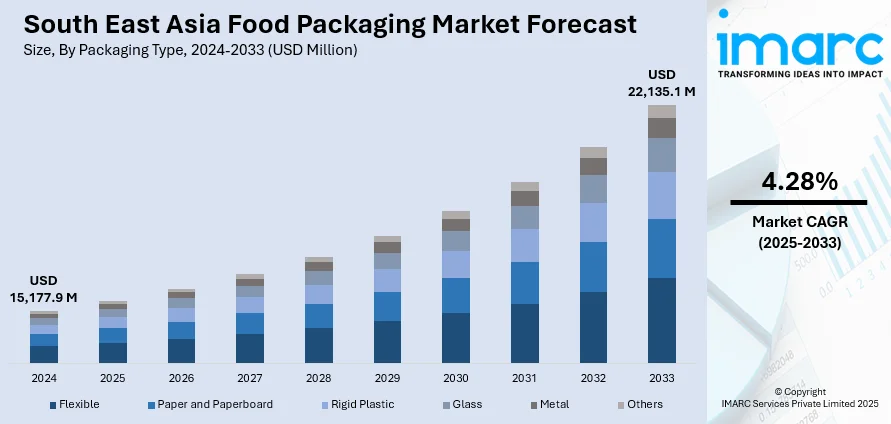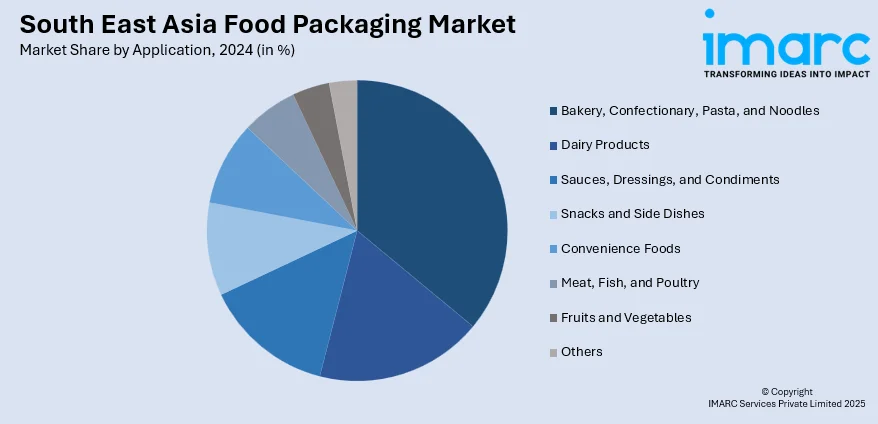
South East Asia Food Packaging Market Size, Share, Trends and Forecast by Packaging Type, Application, and Country, 2025-2033
Market Overview:
South East Asia food packaging market size reached USD 15,177.9 Million in 2024. Looking forward, IMARC Group expects the market to reach USD 22,135.1 Million by 2033, exhibiting a growth rate (CAGR) of 4.28% during 2025-2033. The increasing advances in packaging materials, such as barrier coatings, modified atmosphere packaging, and intelligent packaging, which contribute to improved food preservation and quality, are driving the market.
|
Report Attribute
|
Key Statistics
|
|---|---|
|
Base Year
|
2024
|
|
Forecast Years
|
2025-2033
|
|
Historical Years
|
2019-2024
|
|
Market Size in 2024
|
USD 15,177.9 Million |
|
Market Forecast in 2033
|
USD 22,135.1 Million |
| Market Growth Rate 2025-2033 | 4.28% |
Food packaging refers to the process of enclosing or protecting food products for distribution, storage, sale, and consumption. Its primary purpose is to ensure the safety and quality of the food by preventing contamination, spoilage, and damage during transit and storage. Packaging also serves as a means of communication, providing information about the product, nutritional facts, ingredients, and usage instructions. Over the years, food packaging has evolved from simple materials like leaves and wooden containers to advanced technologies such as plastics, metals, and laminates. Modern packaging methods incorporate innovations like vacuum sealing, modified atmosphere packaging, and smart packaging with sensors to monitor freshness. Sustainability is an increasing focus, leading to the development of eco-friendly and biodegradable packaging options to reduce environmental impact. Overall, food packaging plays a crucial role in preserving the integrity of food products while meeting consumer expectations and regulatory standards.

To get more information on this market, Request Sample
South East Asia Food Packaging Market Trends:
The food packaging market in South East Asia is witnessing substantial growth, driven by several key factors. Firstly, the increasing regional population and changing lifestyles have led to a surge in demand for convenience foods, propelling the need for efficient and innovative packaging solutions. Additionally, rising awareness regarding food safety and hygiene has heightened consumer expectations, prompting the industry to invest in advanced packaging technologies. Moreover, stringent regulations and standards imposed by regulatory bodies have necessitated the adoption of packaging materials that ensure product integrity and compliance. Consequently, manufacturers are inclined towards sustainable and eco-friendly packaging alternatives to meet both regulatory requirements and consumer preferences. Furthermore, the advent of e-commerce platforms and online grocery shopping has spurred the demand for packaging that enhances product shelf life while ensuring convenient transportation. Furthermore, advancements in packaging materials and designs, such as active and intelligent packaging, are contributing to the market's expansion. Active packaging, with features like moisture control and antimicrobial properties, addresses food preservation challenges, while intelligent packaging incorporates sensors for real-time monitoring. These technological innovations are enhancing the overall efficiency and performance of food packaging, reflecting a dynamic market driven by diverse factors. As the industry continues to evolve, collaboration between stakeholders and ongoing R&D are poised to play pivotal roles in shaping the future trajectory of the food packaging market in South East Asia.
South East Asia Food Packaging Market Segmentation:
IMARC Group provides an analysis of the key trends in each segment of the market, along with forecasts at the regional and country levels for 2025-2033. Our report has categorized the market based on packaging type and application.
Packaging Type Insights:
- Flexible
- Paper and Paperboard
- Rigid Plastic
- Glass
- Metal
- Others
The report has provided a detailed breakup and analysis of the market based on the packaging type. This includes flexible, paper and paperboard, rigid plastic, glass, metal, and others.
Application Insights:

- Bakery, Confectionary, Pasta, and Noodles
- Dairy Products
- Sauces, Dressings, and Condiments
- Snacks and Side Dishes
- Convenience Foods
- Meat, Fish, and Poultry
- Fruits and Vegetables
- Others
A detailed breakup and analysis of the market based on the application have also been provided in the report. This includes bakery, confectionary, pasta, and noodles, dairy products, sauces, dressings, and condiments, snacks and side dishes, convenience foods, meat, fish, and poultry, fruits and vegetables, and others.
Country Insights:
- Indonesia
- Thailand
- Singapore
- Philippines
- Vietnam
- Malaysia
- Others
The report has also provided a comprehensive analysis of all the major regional markets, which include Indonesia, Thailand, Singapore, Philippines, Vietnam, Malaysia, and Others.
Competitive Landscape:
The market research report has also provided a comprehensive analysis of the competitive landscape. Competitive analysis such as market structure, key player positioning, top winning strategies, competitive dashboard, and company evaluation quadrant has been covered in the report. Also, detailed profiles of all major companies have been provided. Some of the key players include:
- Foil Packaging Thailand Inc.
- HPI Resources Berhad (Oji Paper Asia Sdn. Bhd.)
- Huhtamaki Group
- PT Primajaya Eratama
- SCG Packaging Public Company Limited
- South East Packaging Industry Co. Ltd.
(Please note that this is only a partial list of the key players, and the complete list is provided in the report.)
South East Asia Food Packaging Market Report Coverage:
| Report Features | Details |
|---|---|
| Base Year of the Analysis | 2024 |
| Historical Period | 2019-2024 |
| Forecast Period | 2025-2033 |
| Units | Million USD |
| Scope of the Report | Exploration of Historical and Forecast Trends, Industry Catalysts and Challenges, Segment-Wise Historical and Predictive Market Assessment:
|
| Packaging Types Covered | Flexible, Paper and Paperboard, Rigid Plastic, Glass, Metal, Others |
| Applications Covered | Bakery, Confectionary, Pasta, and Noodles, Dairy Products, Sauces, Dressings, and Condiments, Snacks and Side Dishes, Convenience Foods, Meat, Fish, and Poultry, Fruits and Vegetables, Others |
| Countries Covered | Indonesia, Thailand, Singapore, Philippines, Vietnam, Malaysia, Others |
| Companies Covered | Foil Packaging Thailand Inc., HPI Resources Berhad (Oji Paper Asia Sdn. Bhd.), Huhtamaki Group, PT Primajaya Eratama, SCG Packaging Public Company Limited, South East Packaging Industry Co. Ltd., etc. |
| Customization Scope | 10% Free Customization |
| Post-Sale Analyst Support | 10-12 Weeks |
| Delivery Format | PDF and Excel through Email (We can also provide the editable version of the report in PPT/Word format on special request) |
Key Questions Answered in This Report:
- How has the South East Asia food packaging market performed so far and how will it perform in the coming years?
- What has been the impact of COVID-19 on the South East Asia food packaging market?
- What is the breakup of the South East Asia food packaging market on the basis of packaging type?
- What is the breakup of the South East Asia food packaging market on the basis of application?
- What are the various stages in the value chain of the South East Asia food packaging market?
- What are the key driving factors and challenges in the South East Asia food packaging?
- What is the structure of the South East Asia food packaging market and who are the key players?
- What is the degree of competition in the South East Asia food packaging market?
Key Benefits for Stakeholders:
- IMARC’s industry report offers a comprehensive quantitative analysis of various market segments, historical and current market trends, market forecasts, and dynamics of the South East Asia food packaging market from 2019-2033.
- The research report provides the latest information on the market drivers, challenges, and opportunities in the South East Asia food packaging market.
- Porter's five forces analysis assist stakeholders in assessing the impact of new entrants, competitive rivalry, supplier power, buyer power, and the threat of substitution. It helps stakeholders to analyze the level of competition within the South East Asia food packaging industry and its attractiveness.
- Competitive landscape allows stakeholders to understand their competitive environment and provides an insight into the current positions of key players in the market.
Need more help?
- Speak to our experienced analysts for insights on the current market scenarios.
- Include additional segments and countries to customize the report as per your requirement.
- Gain an unparalleled competitive advantage in your domain by understanding how to utilize the report and positively impacting your operations and revenue.
- For further assistance, please connect with our analysts.
 Request Customization
Request Customization
 Speak to an Analyst
Speak to an Analyst
 Request Brochure
Request Brochure
 Inquire Before Buying
Inquire Before Buying




.webp)




.webp)












